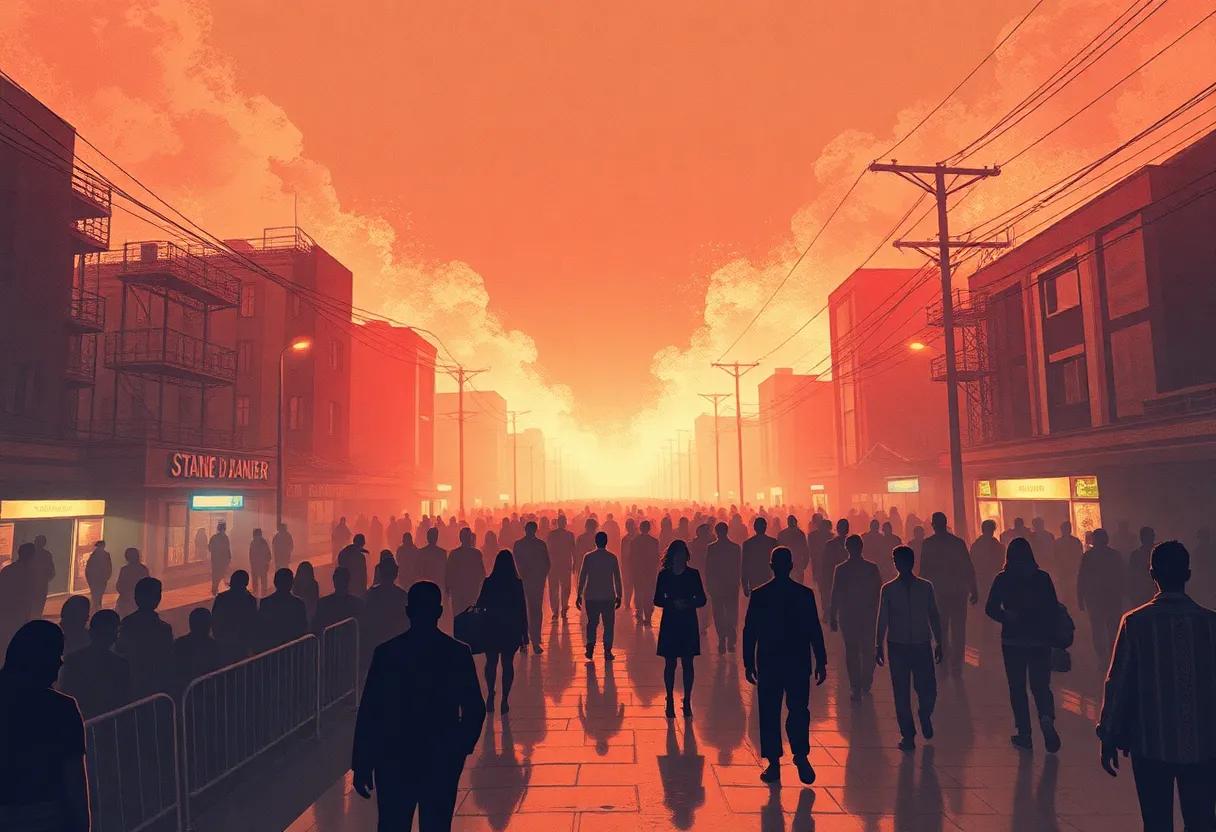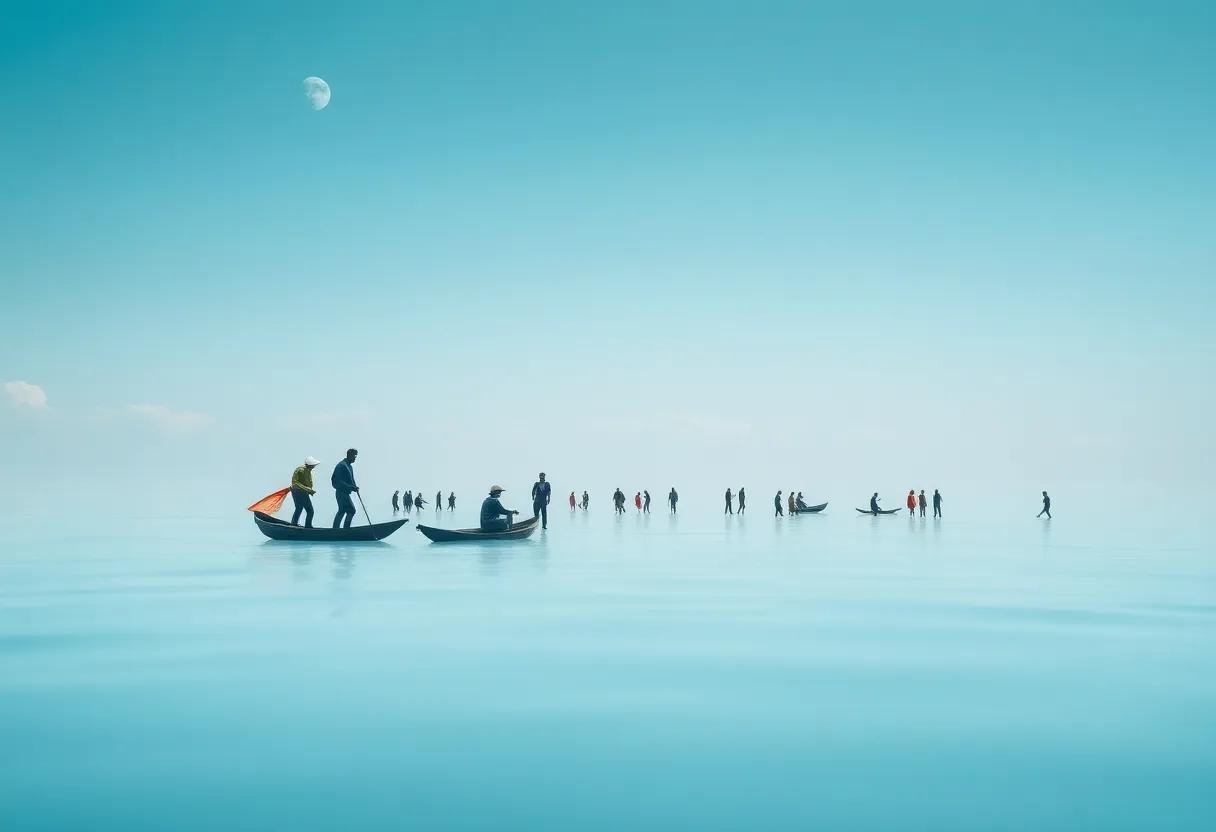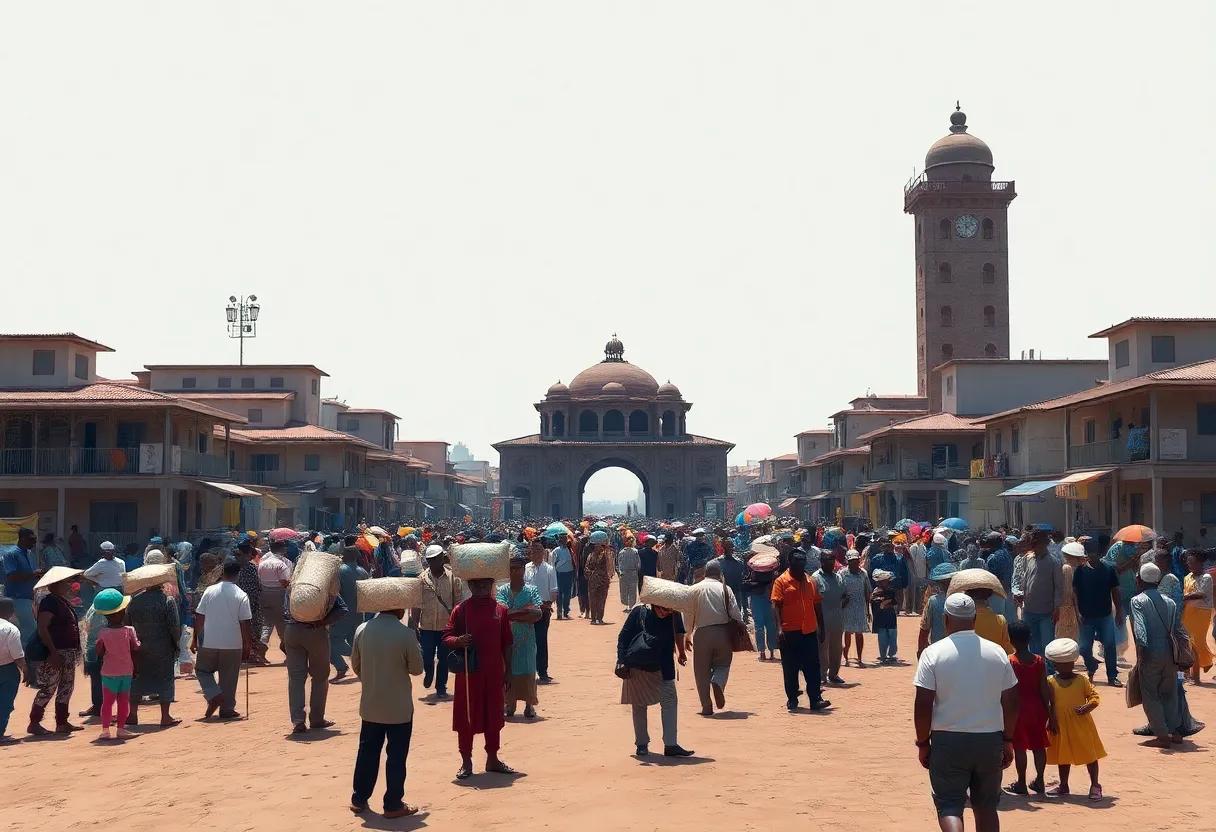in an era when the very notion of overpopulation often drifts between dystopian fantasy and pressing reality, john Brunner’s stand on Zanzibar emerges as a prescient literary lens, exploring the complexities of a future bursting at its seams. Published in 1968, this seminal work ventures boldly into a world where humanity grapples with the consequences of overcrowding, technological acceleration, and social fragmentation. In this review, we delve into Brunner’s visionary narrative-its innovative structure, thematic depth, and enduring relevance-unpacking how Stand on Zanzibar challenges readers to confront the possibilities and perils of tomorrow’s crowded existence.
Imagining a Future Drowned in Crowds and Chaos Delving into the Urban Density and social Dynamics of Stand on Zanzibar
John Brunner’s Stand on Zanzibar paints a vivid portrait of a world teetering on the edge of collapse,where cities pulse with a relentless human tide. The staggering population density isn’t just a backdrop-it’s an omnipresent force shaping every facet of life. Within this dense sprawl, personal space dissolves and social behaviors mutate under pressure, creating a society where anonymity clashes with an overwhelming proximity. Streets become both arteries of survival and stages for conflict, while the constant hum of humanity blurs individual identities into a collective chaos.
Delving deeper,the novel explores complex social dynamics that ripple through overcrowded urban centers,revealing unsettling yet plausible patterns:
- Fragmented communities struggling to maintain cohesion amid spatial strain.
- Heightened tensions triggered by scarce resources and divergent cultural pressures.
- Innovations in social engineering, as governments attempt to impose order without suffocating freedom.
The following table encapsulates some of these dynamics, highlighting the balance between disorder and adaptation:
| Urban Factor | Effect on Society | response Mechanism |
|---|---|---|
| Population Overload | Stress on infrastructure and social services | Strict zoning laws and rationing |
| Loss of Privacy | Increased psychological tension | Communal living units with structured schedules |
| Resource Scarcity | Competition and unrest | Technological advancements and controlled markets |
This intricate tapestry of human conditions not only serves as a cautionary tale but also invites thoughtful reflection on the future trajectories of our own overcrowded cities. Brunner doesn’t simply depict chaos; he exposes the fragile, sometimes hopeful, architectures of social resilience forged in the crucible of urban density.
The Impact of Overpopulation on Resources Technology Innovation and Environmental Challenges Explored Within the Narrative
Within stand on Zanzibar, the relentless surge of humanity shapes every facet of existence, revealing a world teetering under the weight of its own numbers. Resources such as food,water,and energy are strained to their limits,compelling societies to innovate at breakneck speeds. The narrative paints a future where technological breakthroughs are not mere conveniences but necessities, designed to stretch dwindling supplies and maintain a fragile balance. Yet, these advancements come with their own complexities-ethical dilemmas and unforeseen consequences-that challenge the very fabric of human progress.
The novel intricately interweaves these themes through diverse perspectives,emphasizing how environmental degradation becomes both a cause and effect of overpopulation. The struggle to sustain life on Earth is depicted through vivid scenarios that include:
- Urban overcrowding accelerating pollution and waste accumulation.
- Resource rationing prompting social unrest and political upheaval.
- Rapid technological adaptation to manage environmental challenges and quality of life.
| Resource | Impact Level | Technological Response |
|---|---|---|
| Fresh Water | Critical | Desalination Plants & Recycling |
| Energy | high | Renewable Sources & Smart Grids |
| Food Supply | Severe | Vertical Farming & Lab-Grown Meat |
Complex Characters Navigating a World on the Brink Examining Human Resilience and Psychological Depth in Overcrowded Settings
At the heart of Stand on Zanzibar lies a vivid array of characters whose inner turmoil and resilience mirror the chaotic environment around them.Each individual wrestles with personal dilemmas that are intricately linked to the societal pressures of overcrowding-be it psychological strain, ethical ambiguity, or a desperate hunt for identity. from the disillusioned corporate executive navigating the maze of global capitalism to the marginalized youth seeking purpose in cramped urban sprawls, their stories unfold with a raw, emotional intensity that refuses to be neatly packaged. This narrative complexity compels readers to confront the multifaceted nature of human endurance when every inch of space feels contested.
The novel’s portrayal of psychological depth shines through its layered characterization and deft use of contrasting perspectives. Rather than presenting a monolithic dystopia, the story invites contemplation on diverse coping mechanisms-highlighted below are key facets that define human survival amidst such strain:
- Adaptive Innovation: Characters constantly devise small-scale rebellions or technologies to carve out mental or physical space.
- fragmented Relationships: Interpersonal connections fluctuate between potent solidarity and alienation, underscoring a fragile social fabric.
- Emotional Palimpsests: Trauma and hope co-exist, layering protagonists’ experiences and revealing the nuanced spectrum of resilience.
| Character Trait | Manifestation in Overcrowded Context |
|---|---|
| Resourcefulness | Inventing new social codes to navigate scarcity |
| Empathy | Forming unlikely alliances amid distrust |
| Defiance | Refusing to surrender individuality in homogenized spaces |
The Role of Corporate Power and Political Intrigue How Economic Forces Shape the Story’s Dystopian Vision
Stand on Zanzibar masterfully weaves a tapestry where corporate entities are not mere background players but the architects of the dystopian landscape. These conglomerates wield economic might that transcends borders, influencing political decisions with the quiet menace of a puppeteer pulling strings from the shadows. The novel highlights how business interests infiltrate governmental layers, turning policies into commodities traded on power and profit. This economic dominance creates an atmosphere of inevitability where massive corporations dictate societal norms, fueling a cycle of inequality and manipulation that fans the flames of unrest beneath the surface of everyday life.
The political intrigue in Stand on Zanzibar is deeply entwined with these economic undercurrents, presenting a world where details is currency and alliances shift like tectonic plates. Below are key elements driving this complex web:
- Corporate Lobbying: Strategic influence over legislation ensures profit margins are protected at any cost.
- Economic Sabotage: Covert operations aimed at crippling competitors blur moral lines and escalate tensions.
- Media Manipulation: Controlling narratives to maintain public compliance and obscure uncomfortable truths.
- political Corruption: Officials compromised by corporate incentives, reducing openness and justice.
| Force | Effect on Society |
|---|---|
| monopolization | Stifles innovation, centralizes power |
| Economic Inequality | Creates a divided populace, fuels unrest |
| Policy Manipulation | Weakens democratic processes |
| Information Control | Shapes public perception, limits dissent |
Stand on zanzibar’s Visionary Social Commentary on Diversity Inclusion and Fragmented Identities in a Crowded Society
The novel masterfully peels back layers of society,revealing a mosaic of *fragmented identities* navigating a hyperpopulated world. Within its pages, diversity is not merely acknowledged but interwoven into the fabric of everyday life-bringing into sharp focus the tensions, alliances, and shared humanity that emerge when cultures and perspectives collide. Characters embody varied ethnicities, ideologies, and personal struggles, reflecting the complexity of inclusion in a society bursting at the seams. This weaving of voices creates a dynamic tableau where inclusion transcends tokenism, rather portraying a living, breathing community caught between chaos and coexistence.
What sets the social commentary apart is its unapologetic portrayal of overcrowding as both a physical and psychological force shaping identity. The relentless pressure of proximity distills intimacy and alienation alike, forcing individuals to confront how much of themselves must be sacrificed or reshaped for survival. Consider the following facets highlighted throughout the narrative:
- Multiplicity within Unity: Shifting alliances and cultural overlaps create a layered tapestry of belonging.
- Invisible Margins: The underrepresented subtly resist erasure,forming unseen subcultures.
- Identity as Negotiation: Characters constantly redefine themselves in response to societal pressures.
| Aspect | Impact on Identity | Social Implication |
|---|---|---|
| Overpopulation | Heightened stress, shared public spaces | Blurred boundaries, increased social tension |
| Cultural Diversity | Multiplicity of worldviews | Rich innovation, potential fragmentation |
| Economic Disparity | Layered class identities | Unequal access, social stratification |
The Narrative Structure and Literary Techniques That Craft an Immersive and Thought-Provoking reading Experience
Stand on Zanzibar unfolds through a multi-layered narrative that masterfully intertwines diverse perspectives, creating a mosaic of human experience in an overcrowded future. The fragmented storytelling, employing rapid shifts between characters and scenes, mirrors the chaos and complexity of the novel’s crowded world. This technique not only immerses readers into the fast-paced environment but also challenges them to piece together connections, enriching engagement. Vonnegut’s use of intercalary chapters, brimming with factoids, newspaper excerpts, and fictional advertisements, adds authenticity and breadth, blurring the lines between story and social commentary.
The literary craftsmanship shines through in the deft use of recurring motifs and symbolic language that deepen thematic resonance. Such as, the ever-present motif of the “im” – short for “imaginary” – symbolizes societal fears and the fragility of human identity in the face of relentless technological advancement. Techniques such as stream-of-consciousness passages and cryptic dialogues invite readers to explore the psyche of characters grappling with overcrowding, identity, and morality.Below is a brief outline of key narrative elements and literary devices that contribute to the immersive quality:
| Technique | effect | Example |
|---|---|---|
| Intercalary chapters | Provides social context and world-building | Media snippets & reports |
| Fragmented perspectives | Reflects societal chaos and complexity | Shifting character viewpoints |
| motifs (e.g.,”im”) | Symbolizes identity and alienation | “Im” as societal fear |
| stream-of-consciousness | Delves into inner conflict and psyche | character introspections |
Balancing Hope and Despair Insights into the Ethical Questions Raised by Future Urban Living Conditions
In Stand on Zanzibar,the tension between optimism and dread is palpable,painting a multifaceted portrait of a future where urban density tests humanity’s resilience and morality. The novel probes deep into the ethical dilemmas arising from overcrowded environments, asking: How do we preserve individuality amid anonymity? What responsibilities do governments and corporations hold toward the growing masses? Through richly layered narratives, readers confront the paradox of technological progress fostering both connection and alienation. The story highlights scenarios where hope flickers in the form of innovation and social reform, yet is continually shadowed by despair rooted in systemic inequality and environmental degradation.
These questions resonate beyond fiction, inviting us to weigh challenging choices in our real-world urban futures. Some key ethical considerations include:
- Resource Allocation: Who decides access to essentials like housing,clean water,and energy?
- Privacy vs. Surveillance: How much personal freedom can be sacrificed for the sake of public safety?
- Social Stratification: What mechanisms prevent the marginalization of vulnerable communities in dense cities?
| Ethical Challenge | Potential Consequence | Hopeful Approaches |
|---|---|---|
| Overcrowding | Increased stress and conflict | smart urban planning & green spaces |
| Technological Divide | exclusion from opportunities | Equitable tech access programs |
| Environmental Impact | Resource depletion & pollution | Lasting infrastructure & policies |
who Should Read Stand on Zanzibar Exploring Its Relevance for Science Fiction Fans Scholars and Contemporary Readers
Science fiction enthusiasts will find this novel a treasure trove of visionary ideas and speculative technology, as it predates many contemporary concerns about overpopulation, corporate power, and genetic engineering. Its richly layered narrative invites fans to unravel a complex world where social and political issues are intensified by futuristic advancements, making it a compelling read for those who crave more than just escapism. The novel’s experimental storytelling, including fragmented perspectives and interwoven subplots, will intrigue readers who appreciate inventive narrative forms in speculative fiction.
Scholars and academics interested in sociopolitical commentary and dystopian studies will appreciate the novel’s capacity to pose challenging questions about humanity’s future. It serves as a valuable case study in world-building,cultural critique,and the evolution of speculative fiction as a medium for social reflection. Contemporary readers,too,can engage with the text as a mirror reflecting current anxieties about resource scarcity,environmental degradation,and societal fragmentation,prompting useful dialog across generational and disciplinary lines.
- Fans of classic and experimental science fiction
- Students of literature, sociology, and environmental studies
- Readers interested in futurism and demographic challenges
- Those curious about the intersection of technology and ethics
| Reader Type | Key interest | Why Read? |
|---|---|---|
| Science Fiction Fans | Innovative storytelling | Explores societal challenges in a future world |
| Scholars | Cultural critique | offers rich material for interdisciplinary analysis |
| Contemporary Readers | Relevance to present-day issues | Invites reflection on modern population and ethical concerns |
The Legacy of John Brunner His Contribution to Sci-Fi and the Enduring Influence of Stand on Zanzibar
John Brunner remains a towering figure in speculative fiction, largely due to his deft ability to weave complex social issues with cutting-edge science fiction concepts. His work, especially Stand on Zanzibar, transcended traditional narrative structures by integrating fragmented storytelling and a mosaic of perspectives, painting a vivid picture of a world grappling with overpopulation, corporate dominance, and technological saturation. Brunner’s prescience in highlighting the ethical and societal impacts of unchecked growth positioned him not just as a novelist, but as a visionary social critic whose stories remain alarmingly pertinent decades after their publication.
The enduring influence of Stand on Zanzibar is evident in both literary and cultural realms. Its innovative narrative techniques-like “hive state” storytelling-have inspired countless authors and creators to experiment with form and depth, while its thematic concerns continue to echo in conversations about sustainability and human interconnectedness.
- Exploration of population dynamics and resource allocation
- Fragmented, multi-voiced narrative structure
- Early depiction of media saturation and information overload
- Prescient insights into corporate and political power plays
| Aspect | Brunner’s Vision | Modern Parallel |
|---|---|---|
| Population | 8+ billion stressed urban centers | current Earth urbanization trends |
| Technology | Real-time data and media overload | Social media & digital information age |
| Society | Corporate-political entanglement | Big Tech and government relations |
Stand on Zanzibar invites readers to step into a future both familiar and unsettling-a world teeming with life, innovation, and the pressing weight of overpopulation. through its richly imagined tapestry, john Brunner challenges us to reflect on the consequences of our collective choices, making this novel as relevant today as it was decades ago. Whether you approach it as a cautionary tale or a speculative exploration, Stand on Zanzibar remains a thought-provoking journey into tomorrow’s crowded realities, urging us to consider the delicate balance between progress and preservation.








